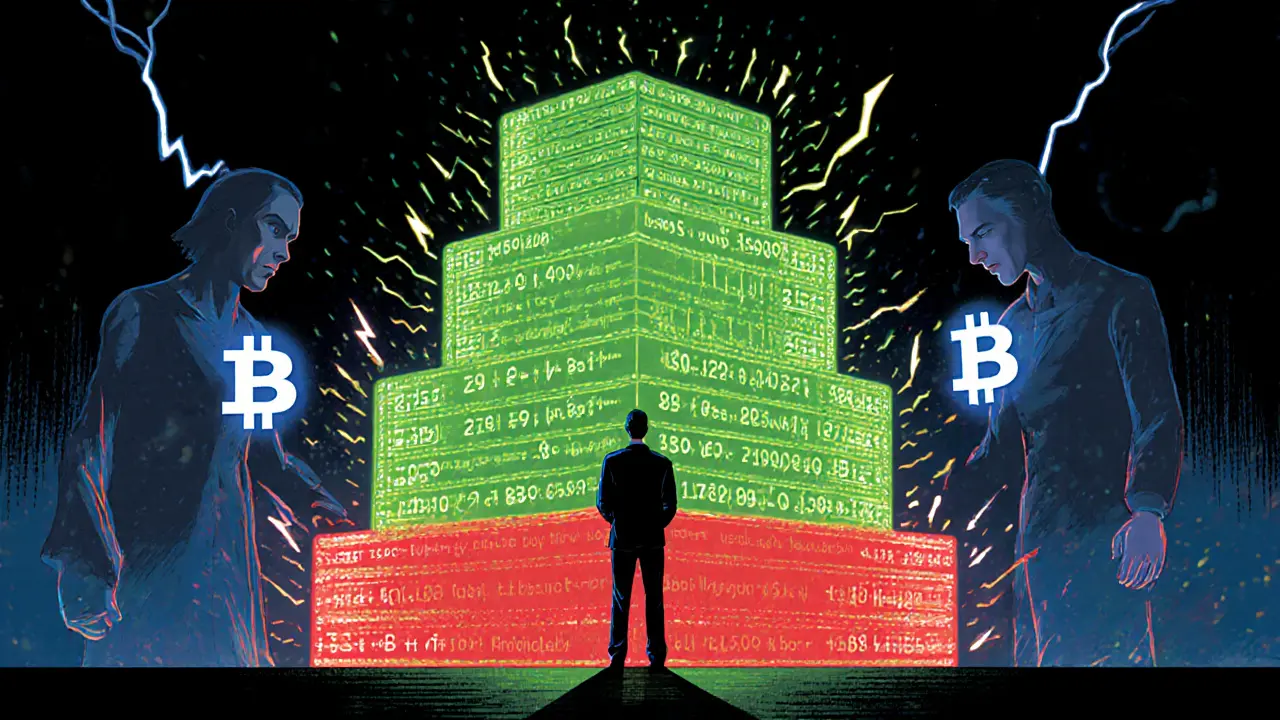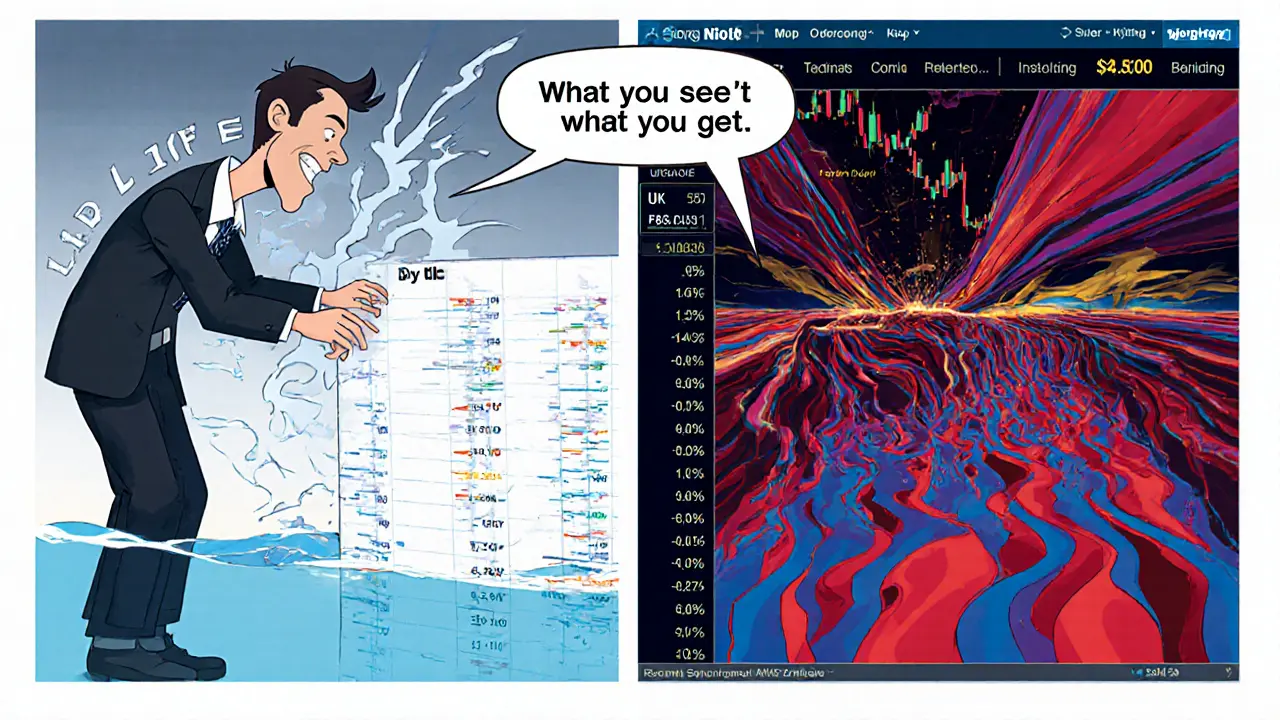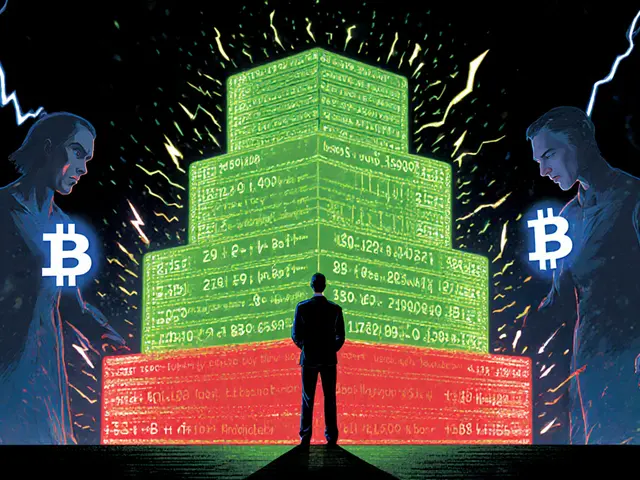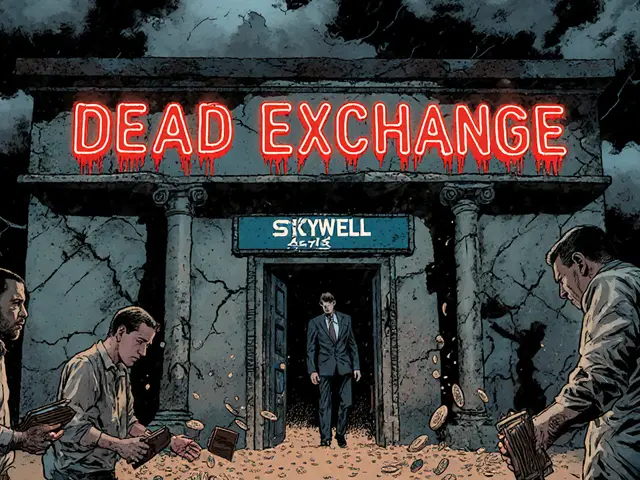- Home
- Cryptocurrency
- Market Depth and Liquidity Analysis in Blockchain Trading

Market Depth and Liquidity Analysis in Blockchain Trading
Market Depth Calculator
Calculate your maximum trade size without significant slippage. Based on the article's 2% depth metric, this tool helps you understand how much you can trade before price moves beyond 2% of your current entry price.
Results will appear here after calculation
Important: Visible depth is often manipulated. Check for liquidity fragility and order flow patterns before trading. This calculation assumes the depth is real and stable.
When you place a trade on a crypto exchange, you’re not just clicking a button-you’re stepping into a hidden world of buy and sell orders stacked like layers of a cake. This is market depth, and it’s what separates smart traders from those who get crushed by slippage. Most retail traders look at price charts and think they understand the market. But without reading the order book, you’re flying blind. In blockchain markets, where volatility is high and liquidity is thin, knowing where the real money sits can mean the difference between a profitable trade and a costly mistake.
What Market Depth Really Means
Market depth is the total volume of buy and sell orders at every price level in the order book. Think of it like a grocery store checkout line: the longer the line, the more people are ready to buy or sell. A deep market has lots of orders stacked up near the current price, so big trades don’t send prices soaring or crashing. A shallow market? One big order can wipe out all the liquidity and send the price sideways-or worse. In traditional markets like U.S. Treasuries, a $1 million trade might move the price by less than 0.1%. But on Coinbase Pro, a $1 million buy order for Bitcoin can easily push the price up 1-2%. Why? Because the 2% depth-the total liquidity within 2% above and below the current price-is only around $8.7 million on average. That’s less than 1% of what you’d find in a major stock or bond market.How Liquidity Is Measured in Crypto
There are three key ways to measure liquidity in blockchain markets:- Order flow: How many orders are coming in per second. High order flow means traders are actively participating, which usually means better liquidity.
- Volume: The total number of coins traded over a set time. High volume doesn’t always mean deep liquidity-someone could be dumping 10,000 BTC in one go, creating fake volume.
- Depth of Market (DOM): This is the visual ladder showing buy and sell orders stacked by price. Most platforms show the top 10-20 levels. The wider the stack at each level, the deeper the liquidity.
The most practical metric is the 2% depth. If you’re trading Bitcoin at $65,000, the 2% depth tells you how much you can buy or sell without moving the price more than 2%. On Binance, BTC’s 2% depth might be $15 million. On a smaller exchange? Maybe $500,000. That’s not just a number-it’s your trading safety net.
Why Crypto Markets Are So Shallow
Crypto markets are inherently less liquid than stocks or forex. Here’s why:- Fragmentation: Bitcoin trades on hundreds of exchanges. Liquidity is split everywhere, so no single order book has deep pools.
- High-frequency trading (HFT): Algorithms place and cancel orders in milliseconds. What looks like a wall of buy orders might vanish the second you try to hit it.
- Iceberg orders: Large traders hide their true size. Only a small portion of their order shows up on the DOM. You see $2 million in bids-but the real order is $20 million.
- Market manipulation: Spoofing is common. Traders place fake large orders to scare others into moving price, then cancel before execution. Reddit users have reported losing money on crude oil and crypto futures because DOM levels disappeared right before their trades filled.
According to a May 2024 study by IOSCO, over 40% of visible depth in equity markets disappears within half a second. Crypto is even worse. What you see isn’t always what you get.

How Institutions Use Market Depth
Big players-hedge funds, market makers, crypto funds-don’t trade like retail traders. They use depth analysis to:- Split large orders into smaller chunks to avoid moving the market
- Time entries when depth is strongest-usually during high-volume hours
- Identify hidden support and resistance levels by watching where large orders accumulate
A proprietary trading firm in Singapore reduced slippage by 22% on E-mini S&P futures using DOM analysis to time entries during peak depth periods. That same strategy works in crypto. On Binance, the best times to trade BTC are 14:00-16:00 UTC and 21:00-23:00 UTC, when volume and depth peak. Outside those windows, liquidity dries up fast.
According to the CFA Institute, 89% of institutional trading desks use depth metrics in their algorithms. But they also warn: retail traders often mistake temporary order imbalances for real liquidity. That’s why so many people get stopped out after seeing a big buy wall that vanishes the moment they click.
Tools and Platforms for Depth Analysis
Not all platforms show depth the same way. Here’s what works:- TradingView Pro: Offers DOM with volume profiling. Good for beginners. Free version shows only price charts.
- NinjaTrader: Popular with professional crypto traders. Real-time DOM with customizable depth levels.
- Bookmap: The gold standard. Uses heatmaps to show order flow visually. Shows hidden liquidity patterns. Costs $299/month.
- Quantower: $149/month. Strong DOM and order flow analytics. Used by 78% of professional traders who reviewed it on BrokerChooser.
- Exchange-native tools: Binance and Kraken show basic DOM. Useful, but limited to 10 levels. No volume profiling.
Most retail traders stick to basic charts because these tools are expensive. But if you’re trading more than $10,000 per trade, the cost pays for itself. A 1% improvement in execution price on a $50,000 trade saves you $500. That’s more than a month’s subscription fee.
How to Read the Order Book Like a Pro
Here’s how to actually use DOM in real time:- Look for clusters: Are there large stacks of buy orders at $64,500 and $64,000? That’s likely support. Sell walls at $66,000? That’s resistance.
- Watch for imbalance: If buy volume is 3x sell volume at the top 5 levels, price is likely to rise-unless the buy orders are fake.
- Check for thinning: If the depth shrinks rapidly over 30 seconds, liquidity is drying up. Don’t enter large trades.
- Spot iceberg orders: A single large order that keeps reappearing just below the top bid? That’s likely a hidden order. It’s a sign of institutional interest.
- Combine with volume: High volume + deep DOM = strong move. High volume + thin DOM = fake breakout.
One trader on Reddit tracked SPY’s DOM for three days and noticed buy orders piling up at $152.35. When price finally reached that level, it bounced 3.2% higher. That’s the power of reading depth-not just price.

The Hidden Risks
Market depth isn’t foolproof. Here’s what you need to watch out for:- Liquidity fragility: During market stress, depth can vanish in minutes. In March 2023, the 2% depth for U.S. 10-year Treasuries dropped from $1.5 billion to $187 million in under an hour. Crypto does this daily.
- Latency: If your data feed is 50 milliseconds behind, your DOM is already outdated. In fast markets, that’s enough to lose money.
- Cost: Professional tools cost hundreds a month. Most retail traders can’t afford them.
- Overreliance: Depth doesn’t predict direction. It only tells you how much volume is available. Combine it with trend analysis and volume patterns.
Stanford Professor Emily Zhao warns that traders who trust visible depth are playing a game rigged by HFT algorithms. “The market depth you see,” she says, “is often a mirage.”
How to Start Using Market Depth
You don’t need to be a quant to use depth analysis. Here’s a simple plan:- Use TradingView’s free DOM on BTC/USDT or ETH/USDT. Just watch for 15 minutes a day.
- Look for patterns: Where do orders pile up? When do they disappear?
- Practice on a demo account for 30 days. Don’t trade real money until you can identify spoofing.
- Once comfortable, add volume profile to your chart. It shows where most trading happened over time.
- Only move to paid tools like Bookmap if you’re trading over $20,000 per trade.
Most successful traders spend 15-20% of their pre-market time analyzing depth. It’s not flashy. But it’s the difference between guessing and knowing.
The Future of Liquidity Analysis
The tools are getting smarter. AI-powered platforms like Tradespoon’s DeepLiquidity AI now predict depth changes with 73% accuracy by learning from years of order book data. Fidelity’s new “Smart Depth Router” uses real-time depth to execute 68% of large orders with less slippage than traditional methods.Regulators are catching up too. After the 2023 Treasury crash, the SEC proposed rules requiring exchanges to disclose standardized depth metrics. If that happens in crypto, we’ll see more transparency-but also more pressure on exchanges to prove they’re not gaming the system.
For now, market depth remains one of the most underused-and most powerful-tools in crypto trading. It doesn’t tell you where price is going. But it tells you if you can even get there without getting crushed.
What is market depth in cryptocurrency trading?
Market depth in cryptocurrency trading refers to the total volume of buy and sell orders visible in the order book at different price levels. It shows how much liquidity is available near the current market price. A deep market has large stacks of orders, meaning big trades won’t cause large price swings. A shallow market has thin order books, so even small trades can move the price significantly.
How is market depth different from trading volume?
Trading volume measures how many coins have been bought and sold over a period, like daily or hourly. Market depth shows how much is ready to trade right now at each price level. High volume doesn’t mean deep liquidity-someone could be dumping a large amount all at once. Depth tells you if the market can absorb that dump without crashing.
What does 2% depth mean in crypto?
2% depth measures the total buy and sell orders within 2% above and below the current market price. For example, if Bitcoin is trading at $65,000, 2% depth looks at all orders between $63,700 and $66,300. It’s a standard metric used by professionals to gauge how much you can trade without moving the price. In crypto, 2% depth is often under $10 million, compared to over $1 billion in U.S. Treasury markets.
Can market depth be manipulated?
Yes. Market depth is frequently manipulated through spoofing-placing large fake orders to trick others into thinking there’s strong support or resistance, then canceling them before execution. Iceberg orders, where only a small part of a large order is visible, also hide true liquidity. High-frequency trading algorithms exploit these patterns, making visible depth unreliable if not combined with volume and timing analysis.
Do I need expensive tools to use market depth analysis?
No, but it helps. Free tools like TradingView’s basic DOM let you see order book levels. For serious traders, tools like Bookmap or NinjaTrader offer heatmaps, volume profiling, and real-time order flow-critical for spotting spoofing and hidden liquidity. If you’re trading under $5,000 per trade, free tools are enough. For larger trades, the cost of these tools pays for itself by reducing slippage.
How can I tell if depth is real or fake?
Look at the order flow. Real depth stays consistent over time. Fake depth vanishes quickly when you try to trade it. Watch for orders that appear and disappear in under 5 seconds. Also, check volume-real support levels have consistent trading activity behind them. Combine DOM with volume profile and time-of-day patterns to spot manipulation.
Is market depth useful for long-term crypto investors?
Not directly. Long-term investors focus on fundamentals, adoption, and macro trends. But even they benefit from understanding liquidity when entering or exiting large positions. Knowing where deep liquidity lies helps avoid buying at panic lows or selling at fake highs. It’s a tool for execution, not prediction.
Which exchanges have the deepest liquidity for Bitcoin?
Binance, Coinbase Pro, and Kraken typically have the deepest BTC liquidity among major exchanges. Binance leads in volume and order book depth, especially during peak trading hours (UTC 14:00-16:00 and 21:00-23:00). Smaller exchanges like Bybit or OKX have lower depth, making them riskier for large trades. Always check 2% depth on the platform you’re using before placing a big order.
Cormac Riverton
I'm a blockchain analyst and private investor specializing in cryptocurrencies and equity markets. I research tokenomics, on-chain data, and market microstructure, and advise startups on exchange listings. I also write practical explainers and strategy notes for retail traders and fund teams. My work blends quantitative analysis with clear storytelling to make complex systems understandable.
Popular Articles
About
DEX Maniac is your hub for blockchain knowledge, cryptocurrencies, and global markets. Explore guides on crypto coins, DeFi, and decentralized exchanges with clear, actionable insights. Compare crypto exchanges, track airdrop opportunities, and follow timely market analysis across crypto and stocks. Stay informed with curated news, tools, and insights for smarter decisions.







